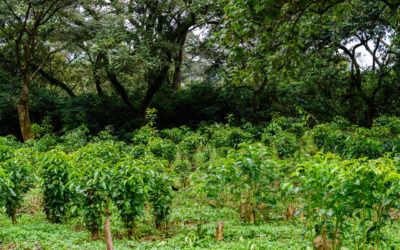Early Sunday morning, December 4, 2022 I arrived in Addis Ababa, Ethiopia, after a long journey. Clearing immigration went smooth and the hotel shuttle took me immediately to the hotel, where I quickly found my bed for a few hours of good sleep. In the afternoon I managed to do some site seeing. What you might not realise is that Addis Ababa is based in the Ethiopian Highlands, at an altitude of 2.300m. So even walking the stairs is already exhausting. I for sure had to get used to that. But exercising was not the aim of this journey. This journey was all about discussing how we can better support the coffee supply chain. Unfortunately, I did not manage to visit any coffee farms this time, as they were too busy harvesting.
A few facts about coffee and Ethiopia
Ethiopia is one of the world’s largest coffee producers and exporters, and coffee plays a significant role in the country’s economy, accounting for over 60% of the country’s total export earnings. You might not be aware, but Ethiopia is the birthplace of coffee, and it is believed that coffee was first discovered in the country in the 9th century. Although, Ethiopia is a large exporter, still over 50% of the produced coffee is being consumed locally.
Coffee is grown in various regions of Ethiopia, with the largest production coming from the South. Other major coffee-growing regions include Oromia, Amhara, and Tigray.
Ethiopia is known for producing a wide variety of coffee varieties, including Arabica, Robusta, and others. Arabica is the most widely grown type of coffee in Ethiopia, and it accounts for about 95% of the country’s total coffee production. The majority of coffee production in Ethiopia is done by 15 million small-scale farmers who often grow coffee as a part of a mixed farming system. Besides, “wild” coffee berries are being picked from the forrest.
The coffee industry in Ethiopia faces challenges such as low prices, quality issues, climate challenges and a lack of infrastructure, but efforts are being made to improve these issues and increase sustainability in coffee production.

Meetings with industry representatives
During my visit, together with a colleague we met with several local representatives of different organisations. Although, with most of them online meetings took place before, it became clear how important face to face meetings still are. Communication was a lot less formal and a lot more information got exchanged, without connections being dropped once in a while.
The Ethiopian coffee challenges
Based on several sources and the meetings, we managed to get more clarity about the major challenges the coffee unions and cooperatives are facing. Their major issues are among others farmer financing (handling the cash), farmer productivity/coffee quality, farmer data registration, e-commerce/direct market access, and inventory management. Issues that can (partially) be solved through digitisation.
Our vision well received
The meetings in Addis were important to validate our assumptions and to conclude if we understood the problems well, which fortunately was the case. Even better, it appeared that our holistic approach was very much appreciated. Currently, organisations too often focus on solving single issues, resulting in the fact that projects hardly every continue beyond the project phase. We feel that it is important to change the system in a self sustainable way, without the need of external sponsorship after the initial project start. This basically means that part of the result of an intervention should be either commercial gain or significant cost savings, and preferably even both.
Partnerships essential
Realising the vision we have in mind, will not be possible without partnerships. A few of the potential partners I managed to meet with in Ethiopia. Other partners I met with in Nairobi, Kenya. It is heartwarming to see how many organisations are willing to improve the situation of the Ethiopian coffee farmers in a sustainable way. And once we have started introducing our solutions in Ethiopia, we will introduce them to other countries and other crops as well.




0 Comments